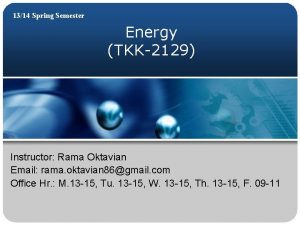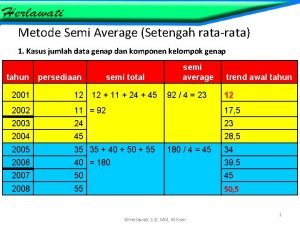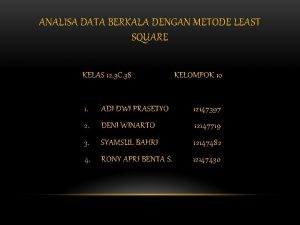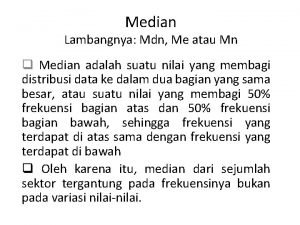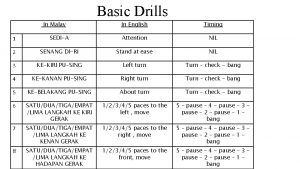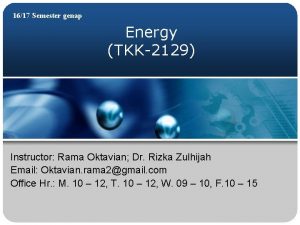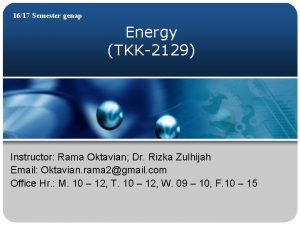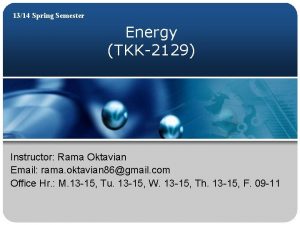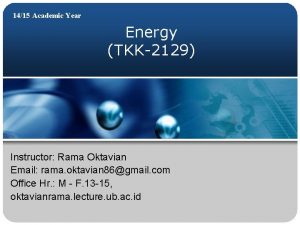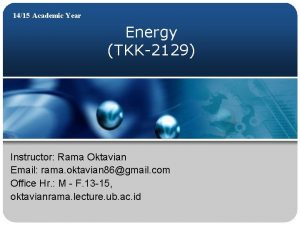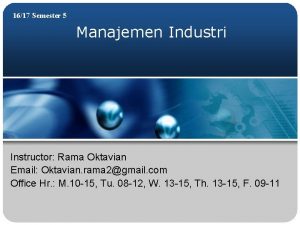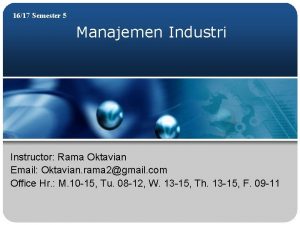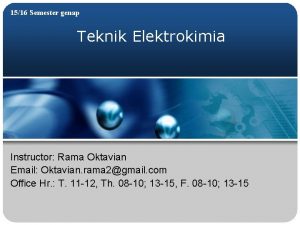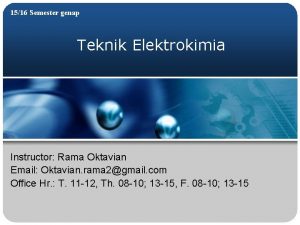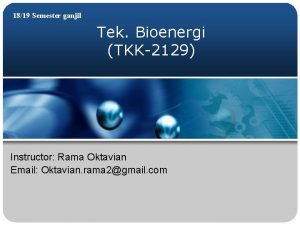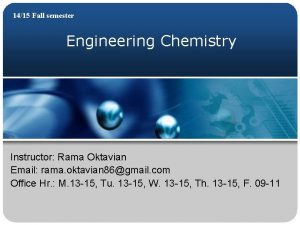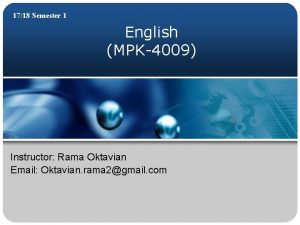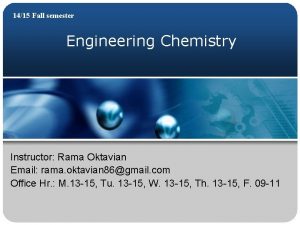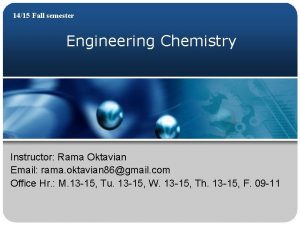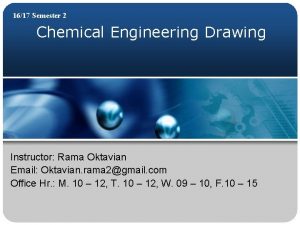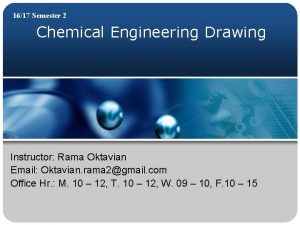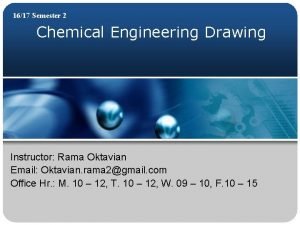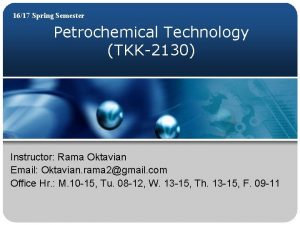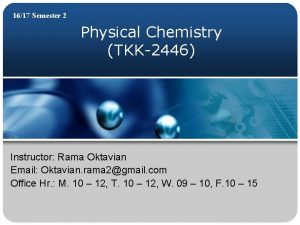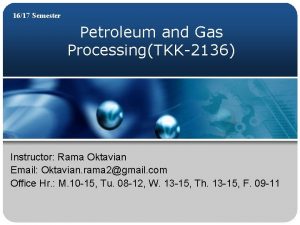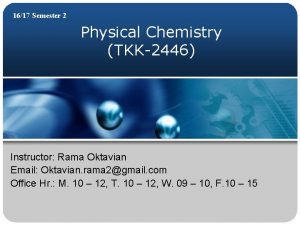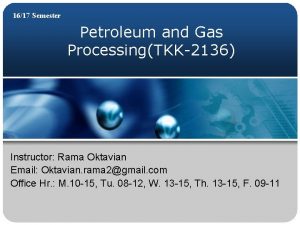1617 Semester genap Energy TKK2129 Instructor Rama Oktavian



























- Slides: 27

16/17 Semester genap Energy (TKK-2129) Instructor: Rama Oktavian; Dr. Rizka Zulhijah Email: Oktavian. rama 2@gmail. com Office Hr. : M. 10 – 12, T. 10 – 12, W. 09 – 10, F. 10 – 15

Outlines 1. Coal: Introduction 2. Coal power plant 3. Coal to chemical (CTC) 4. Recent status of coal technology

Coal (Intro) Coal is conventional fossil fuel Formation of Coal deposits are formed from plant material that died and was deposited in a swampy environment - low in O 2 Anaerobic bacteria convert the organic material until environment becomes too acidic and the bacterial die - decomposition stops when the plants have been converted to peat Peat becomes buried at bottom of swamp Peat is transformed at high pressure and low temperature (< 200 °C) over ~300 million years to coal

Coal (Intro) Coal is conventional fossil fuel Formation of Coal

Coal (Intro) Coal Mining v. Surface Mining v. Strip Mining v. Underground Mining

Coal (Intro) Types of coal

Coal (Intro) Types of coal

Coal (Intro) Types of coal

Coal (Intro) Chemical composition of coal Source: http: //f 03. classes. colgate. edu/fsem 037 -coal/Coal/Default/composition_of_coal. htm

Coal source Energy sources in Indonesia Coal

Coal source Energy sources in Indonesia Coal

Coal source Energy sources in Indonesia Coal

Coal power plant Process equipment v Feedwater used in a steam boiler to transfer heat energy from the fuel burning area to mech. Energy of spinning steam turbine v Boiler v Rectangular furnace, pulverized coal is blown in from fuel nozzles at 4 corners. The coal then burns quickly and forms a fireball at the center.

Coal power plant Process equipment v Steam Turbine Generator v Is a series of steam turbines interconnected to each other and then a generator v Steam Condenser v Steam enters from the turbine generator and is pumped into the bottom of the condenser, where pumps recycle the condensed steam from the feedwater v Stack v Releases process emissions.

Coal power plant Process diagram

Coal power plant Pros v Cheap v. Cheaper unit energy than oil or natural gas v. Will continue to be an important global resource v Abundance v. Coal is the world’s most abundant fossil fuel v. Sufficient reserves for the next 250 years

Coal power plant Pros v Efficiency v. Larger power plants are more efficient v 38% of the chemical energy is converted to energy v Safe vsafest fossil fuel to transport, store and use

Coal power plant Cons v Environmental issues v. Coal-Fired Power Plants are the largest contributor of hazardous air pollutants. o o Sulfur dioxide (SO 2) Nitrogen Oxide (NOx) Carbon Dioxide (CO 2) Mercury

Coal power plant Cons v CO 2 o carbon dioxide pollution, making energy use the single largest source of greenhouse gases in the world

Coal power plant Cons v SO 2 o Sulfur dioxide combined with nitrogen oxide react with water and oxygen in the atmosphere to form acidic compounds, which can mix with natural precipitation and fall to the earth as acid rain. o Sulfur dioxide can also combine with nitrogen oxide and other particles to form particulate matter. o trigger heart attacks and strokes o lead to cardiac arrhythmia (irregular heartbeat) o respiratory irritation, and worsen asthma. o premature death (Both short-term and long-term exposure)

Coal power plant Cons v NOx v When nitrogen oxide (chemically) reacts with volatile organic compounds (VOC’s) and sunlight ground-level ozone or smog is formed.

Coal power plant Cons v Mercury v One of the most dangerous pollutants released into the air through the exhaust system when coal is burned.

Coal power plant Cons § SOx – de-SOx slurry injection § NOx – de-NOx ammonia/urea injection, selective catalytic reduction § Particulate Matter (PM) – bag filters/electrostatic precipitators § CO / CO 2 – CO usually not an issue with well-controlled power plants – CO 2: “carbon capture and sequestration” – Much research into Carbon Capture coal power plants

Example for discussion A coal fired power plant burns 300 tons of sub-bituminous coal per hour to yield 620 MWe. a) What is the primary energy content? b) How much energy was produced? c) What is the efficiency of the process?

Example A) looking at the coal slide that came before we get sub-bituminous coal yields 24 GJ/ton Therefore 300 tons x 24 GJ/ton = 7, 200 GJ = 7. 2 TJ B) Taking the 620 MW over an hour, we get 620 MW x 3600 s = 2. 23 TJ C) Efficiency is the ratio between the produced power and the primary power 2. 23 TJ / 7. 2 TJ = 32. 3% efficiency

Efficiency of a series of processes From conversion chain: combustion (& heat exchanger) → steam turbine → electric generator → distribution grid → appliance

 Rama oktavian
Rama oktavian Materi akidah akhlak kelas 7 semester genap
Materi akidah akhlak kelas 7 semester genap Kitaran hidup rama-rama sains tahun 2
Kitaran hidup rama-rama sains tahun 2 Sri rama sri rama sri manoharama
Sri rama sri rama sri manoharama Metode semi average data genap
Metode semi average data genap Metode semi average adalah
Metode semi average adalah Materi deret fourier
Materi deret fourier Metode least square genap
Metode least square genap Metode semi rata rata data ganjil
Metode semi rata rata data ganjil Tentukan deret fourier dari fungsi berikut
Tentukan deret fourier dari fungsi berikut Diantara bilangan bulat antara 101 - 600
Diantara bilangan bulat antara 101 - 600 Margo folii
Margo folii Contoh median
Contoh median Nombor genap in english
Nombor genap in english Energy energy transfer and general energy analysis
Energy energy transfer and general energy analysis Energy energy transfer and general energy analysis
Energy energy transfer and general energy analysis Tipos de instructor
Tipos de instructor Basic instructor course tcole
Basic instructor course tcole Basic instructor course texas
Basic instructor course texas Basic instructor course #1014
Basic instructor course #1014 Pepperball training manual
Pepperball training manual Not only the students but also their instructor
Not only the students but also their instructor Instructor vs teacher
Instructor vs teacher Ospfv
Ospfv Mptc firearms instructor manual
Mptc firearms instructor manual Tcole advanced instructor course
Tcole advanced instructor course Basic instructor course texas
Basic instructor course texas The virtual instructor elements of art
The virtual instructor elements of art
